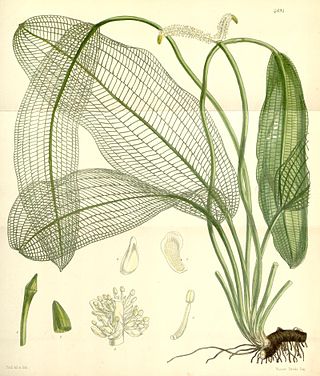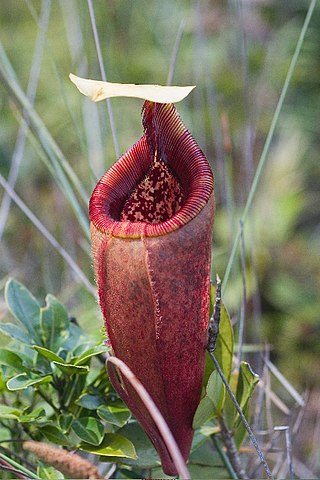
Aponogeton madagascariensis is commonly known as Madagascar laceleaf, lattice leaf or lace plant. It is an aquatic plant native to Madagascar, popularly sold for use in aquariums.
Erythrina schliebenii is a species of legume in the family Fabaceae. It is found only in Tanzania. The species is named for German collector and botanist Hans-Joachim Schlieben.

Roscheria is an endangered, monotypic genus of flowering plant in the palm family. The genus is named for Albrecht Roscher, a 19th-century German explorer, and the epithet for its single species R. melanochaetes derives from Latin and Greek meaning 'black' and 'bristle', alluding to the spines covering the trunks. They naturally occur on the Mahé and Silhouette Islands of Seychelles where they grow in mountainous rainforest and are threatened by habitat loss.

Anacolosa densiflora is a species of plant in the Olacaceae family. Currently, it is an endangered species that is endemic to India.
Buddleja jamesonii is a species endemic to southern Ecuador, where it grows in moist, protected ravines and borders of tussocks at elevations of 3,000 – 4,000 m. The species, first named and described by Bentham in 1846, is now threatened by habitat loss. The specific name commemorates the Scottish botanist William Jameson (1796-1873) who collected in Ecuador.
Buddleja lanata is a species endemic to Ecuador where it grows on dry, windy plateaux amid grasses and bracken at elevations of 1,150 – 2,700 m. The species, first named and described by Bentham in 1845 is now threatened by habitat loss.

Eucrosia aurantiaca is a species of plant which is endemic to Ecuador. Its natural habitats are subtropical or tropical dry forests and subtropical or tropical dry shrubland. It is threatened by habitat loss.

Eucrosia is a genus of herbaceous, perennial and bulbous plants in the Amaryllis family distributed from Ecuador to Peru. The name is derived from the Greek eu, beautiful, and krossos, a fringe, referring to the long stamens. As circumscribed in 2020, the genus contains six species. Phaedranassa and Rauhia are the genera most closely related to Eucrosia.
Eucrosia stricklandii is a species of plant which is endemic to Ecuador. Its natural habitats are subtropical or tropical dry forests and subtropical or tropical dry shrubland. It is threatened by habitat loss.

Nepenthes mantalingajanensis is a tropical pitcher plant known only from the summit region of Mount Mantalingajan, the highest point on the Philippine island of Palawan, after which it is named.
Dypsis brevicaulis is a species of flowering plant in the Arecaceae family. It is a dwarf palm found on only three sites in Madagascar, with fewer than fifty plants ever found in the wild. The plant is part of the IUCN Sampled Red List Index for Plants, a study of representative species from all over the world which is studying extinction trends for plants.

Eucrosia bicolor is a species of plant found in Ecuador and Peru. Its natural habitats are seasonally dry lowland areas. It was the first species of Eucrosia to be scientifically described, in 1817, and the first to be introduced into cultivation in Europe, flowering outside its homeland for the first time in 1817. It is the most widely grown species of Eucrosia.
Eucrosia eucrosioides is a species of plant that is found in south west Ecuador and north Peru. Its natural habitats are seasonally dry lowland areas.
Eucrosia mirabilis is a species of plant from Ecuador. In the original scientific description in 1869, it was believed to be from Peru, but there is little evidence it ever grew there. The plant disappeared from cultivation until it was found in Ecuador in 1997. Its natural habitats are seasonally dry lowland areas to elevations of 1500 m.
Eucrosia calendulina is a species of plant that is endemic to Peru.

Agave parviflora is a species of succulent perennial flowering plant in the asparagus family, known by the common names Santa Cruz striped agave, smallflower century plant, and small-flower agave. It is native to Arizona in the United States and Sonora in Mexico.

Clethra barbinervis, the Japanese clethra, is a species of flowering plant in the family Clethraceae. It is native to eastern Asia, where it is found in southern China, Korea, and Japan. Its natural habitat is in open mountain forests. It is a common species in Japan, and is often found in disturbed secondary forests.

Urceolina is a genus of South American plants in the amaryllis family native to Bolivia, Brazil, Colombia, Costa Rica, Ecuador, Guatemala, Panama, and Peru. It has also been introduced to many South and Central American states, as well as India and Sri Lanka. The formerly accepted genera Eucharis and Caliphruria are now regarded as synonyms of this genus. Many species of this genus share the common name Amazon lily.

Iris atrofusca is a species in the genus Iris, where it is placed in the subgenus Iris and the section Oncocyclus. It is a rhizomatous perennial from the deserts of Israel and Jordan. The species has long falcate (sickle-shaped) or ensiform (sword-shaped) leaves, a long thick stem and large fragrant flowers that come in shades of purple brown, reddish-black, black-brown, dark brown, dark lilac or dark purple. The flowers also have a black or brownish-black signal patch and a thick beard that is brown-black, light brown or yellow tipped with brown. It is rarely cultivated as an ornamental plant in temperate regions.

Protea angustata, also known as the Kleinmond sugarbush, is a flowering shrub that belongs to the genus Protea. This plant is endemic to the south-west Cape Region of South Africa.












